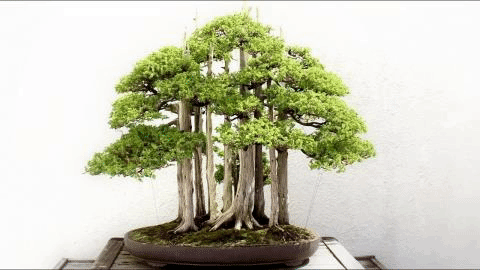IT has been said that Japanese Cherry Blossom trees are sacred - often referred to in Japanese folklore as a tree inhabited by spirits, referred to as 'kami', these trees are rich with history and supposedly symbolize the very essence of life and death.

Perhaps it is as a result of their short lifespan, or the fact that the blossoms themselves only showcase their beauty for a short time before falling to the earth to be once more forgotten, at least until their next return.
Those blossoms considered to be sacred or inhabited by a spirit are often marked using a large, thick rope and it is said that anyone who brings harm to such a tree, shall be cursed for life.
A tale of life, death and what follows:
In history, one blossom stands out among the rest and is said to harbour the soul of an old samurai who had committed the act of Hara-kiri beneath that very tree.
The samurai as a child had played beneath the tree and, as he aged and started to outlive family members and his very own children, he grew lonelier and lonelier. Then, a day came in summer when the tree, which he greatly adored, also died and the samurai grew sadder and lonelier by the day.
Neighbours of the samurai, who noted his growing sorrow, went in search of a young cherry tree for the samurai and, when it was found, was presented to him. Pretending to be grateful for their kind gesture, he thanked his neighbours. As a courtesy, the neighbours also planted the tree in the samurai's garden, hoping that it would comfort him, however, it never did and he simply grew sadder with each passing day, until he remembered how the tree might be saved.
In Japanese culture, it is believed that one can trade one's own life for that of another, including creatures and even trees, if the gods so see fit. In Japanese, this is referred to as: migawari ni tatsu - 'to act as a substitute'.
Now, in the district of Wakegori, the tree believed to be inhabited by this samurai, blooms each and every year on January 16 - the day the samurai died.
The name of the tree in Japanese is: Jiu-roku-zakura, or 'The Cherry-tree of the Sixteenth Day' in English.
According to an ancient text, the samurai's last words, which were spoken to the tree, include: "Now deign, I beseech you, once more to bloom, because I am going to die in your stead."
How to grow your own Cherry Blossom:
Now, if you wish to proceed in learning how to grow your own tree from seed, I hope you will appreciate the great history and significance this tree boasts and also, look after it as though it truly is a part of you.
My personal advice would be to order or purchase multiple seeds as opposed to simply buying one seed as germination can be tricky with only 35 to 55% of seeds germinating successfully, depending on the quality of the seed of course.
The seeds have a deep dormancy and require several treatments before they may be sowed - it is advised to place the seeds in a net in which they will not fall through, and place in a flowing river for 48 hours. If you use your imagination, this can easily be done.
Once removed from the water, allow the seeds to dry of and then, prepare a mixture of sieved peat and sharp sand - equal parts of 50/50 and mist it slightly however, not so much that it is wet but merely damp instead.
Gather your seeds and place them in the mixture and into a plastic bag - place it in the fridge for a period of precisely 14 weeks after which you may proceed to plant the seeds in an area, or pot, where plenty of sunlight and drainage is possible.
Despite being adaptable to most soil types, these trees enjoy soils which are acidic and you should include peat moss, preferably Canadian in the mixture to ensure that moisture levels are maintained.
Post care, and once of age should include watering heavily once per month and, if you would like your tree to blossom, refrain from pruning for an entire year.
Ensure that the tree receives organic fertilizer monthly during the growing season and remember, they grow quite out of control and are rather difficult to shape so, ensure that wiring is done efficiently to maintain its shape.
Pruning and wiring should only be done during spring and, it is also advised to water daily, to every second day, especially if the tree receives 100% full sun - do not water heavily unless the monthly watering time has arrived - you may submerge the pot in water until it has completely filled with water.
THAT'S A WRAP
JOIN OUR #BonsaiCommunity | #TeamBonsai | #TeamHorticulture: (Discord Invite Link: https://discord.gg/nAWEDpK )
The known #BonsaiCommunity | #TeamBonsai | #TeamHorticulture members include (and you should follow them for cool content):
@creativetruth | @daniellozada | @romanolsamuels | @bonsaiaustin | @imagendevoz | @synekto | @shadowolfdg | @mrbloom | @willymac | @mattlovell
Comment below with your handle and, if you post bonsai/horticulture related content your handle could appear above.
READ SOME OF MY OTHER ARTICLES:
#Steemit: Should high profile accounts be allowed to 'self upvote'?
#BonsaiNews: Grow your own pomegranate tree!
#BonsaiNews: Bonsai is always a 'work in progress'
#BonsaiNews: Bonsai is such a niche market on Steemit - I made a plan
#BonsaiNews: People and their opinions matter but........ [RANT]
#Guide: How to convert your SBD into Steem using the internal market [EASY]
